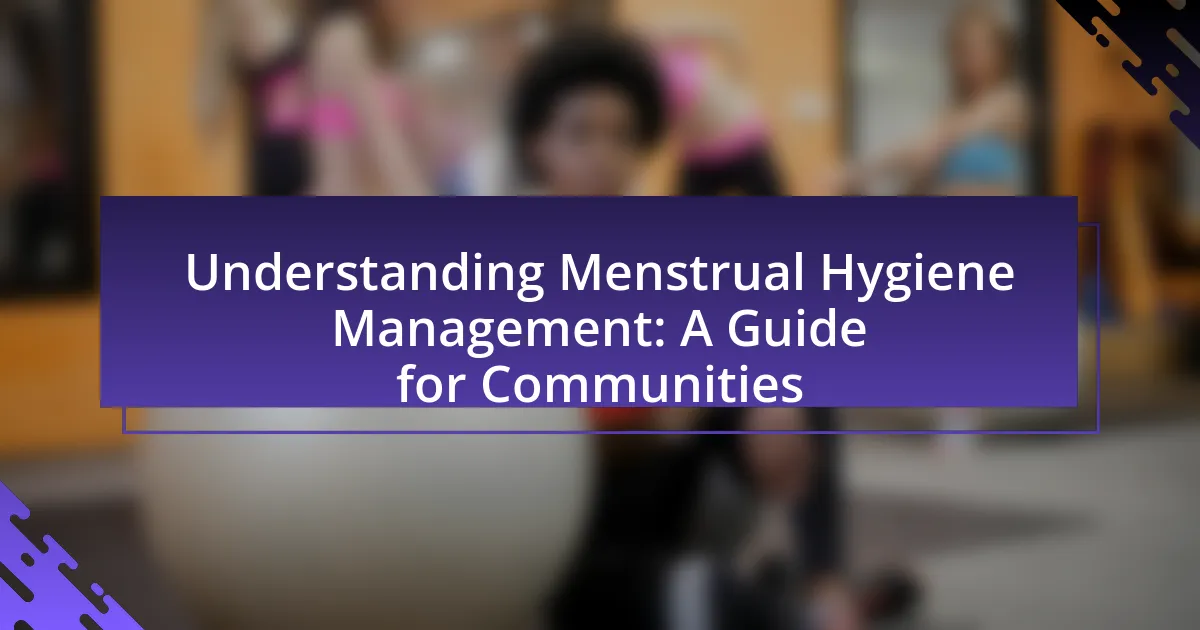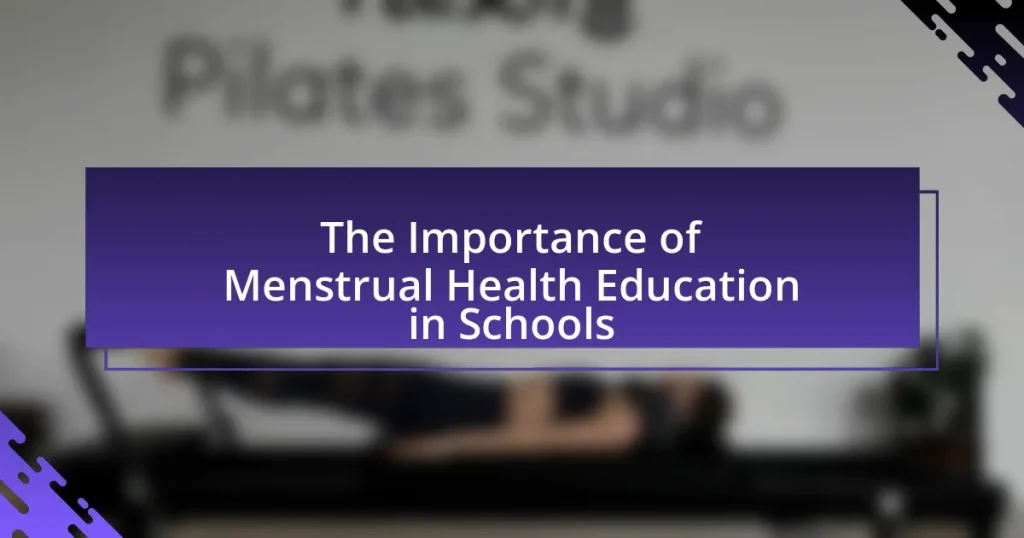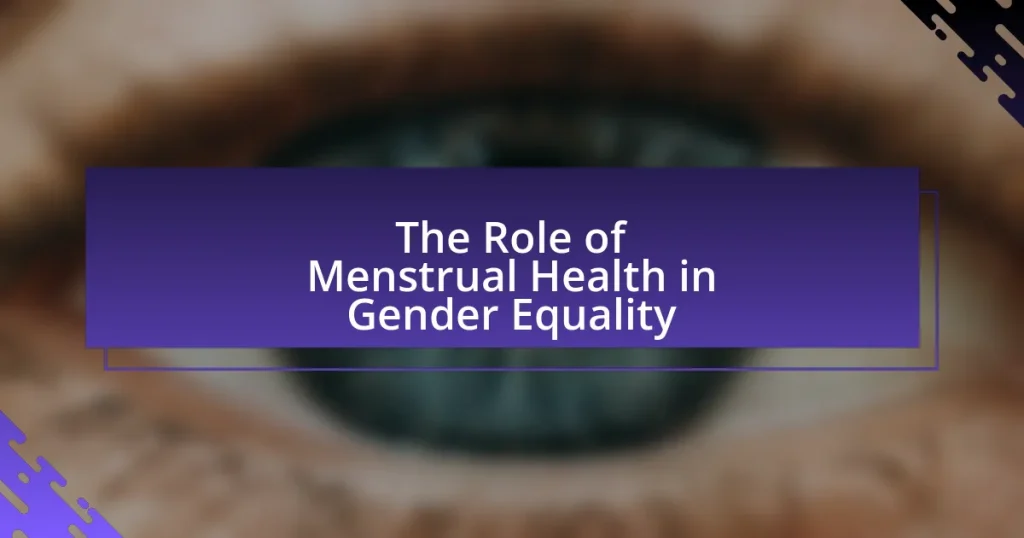Menstrual Hygiene Management (MHM) encompasses the practices and resources necessary for individuals to manage menstruation safely and hygienically, including access to clean products and proper disposal methods. This article highlights the importance of MHM for community health, education, and gender equality, detailing the health implications of poor menstrual hygiene and its impact on school attendance and employment opportunities. Key components of effective MHM, such as education, access to products, and supportive policies, are discussed, along with challenges communities face, including cultural stigma and lack of resources. The article also outlines best practices for maintaining menstrual hygiene and showcases successful community programs that have improved MHM, emphasizing the need for tailored approaches to address cultural contexts and enhance awareness.
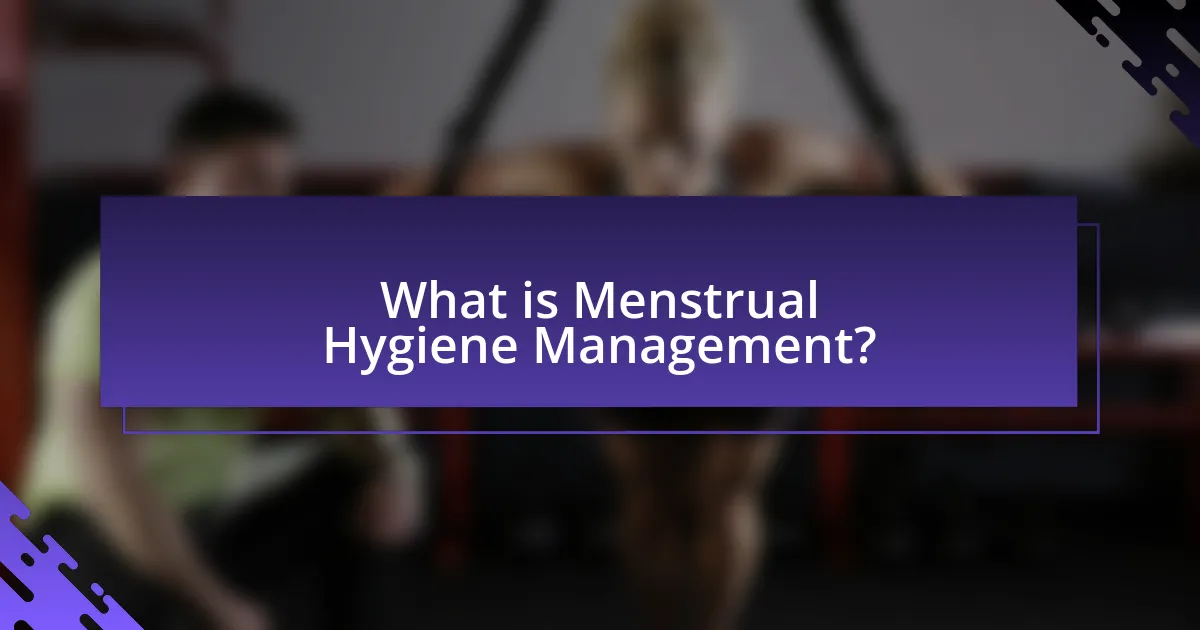
What is Menstrual Hygiene Management?
Menstrual Hygiene Management (MHM) refers to the practices and resources that enable individuals to manage their menstruation safely, hygienically, and with dignity. MHM encompasses access to clean menstrual products, proper disposal methods, and facilities for washing and changing, which are essential for maintaining health and preventing infections. According to the World Health Organization, inadequate menstrual hygiene can lead to health risks and social stigma, highlighting the importance of effective MHM in promoting overall well-being and gender equality.
Why is Menstrual Hygiene Management important for communities?
Menstrual Hygiene Management (MHM) is crucial for communities because it directly impacts health, education, and gender equality. Effective MHM practices reduce the risk of infections and reproductive health issues, as studies show that inadequate menstrual hygiene can lead to serious health complications. Furthermore, when girls have access to proper menstrual hygiene resources, their school attendance improves; research indicates that 1 in 10 girls in Africa misses school during menstruation, which can hinder their educational attainment. Lastly, promoting MHM fosters gender equality by empowering women and girls to participate fully in society without the stigma associated with menstruation.
What are the health implications of poor menstrual hygiene?
Poor menstrual hygiene can lead to significant health implications, including an increased risk of reproductive tract infections, urinary tract infections, and other gynecological disorders. Studies indicate that women and girls who do not manage their menstrual hygiene properly are more susceptible to infections due to the use of unclean materials, lack of access to sanitation facilities, and inadequate knowledge about menstrual health. For instance, a study published in the Journal of Women’s Health found that poor menstrual hygiene practices are linked to a higher prevalence of bacterial vaginosis and candidiasis. Additionally, inadequate menstrual hygiene can contribute to psychological issues, such as anxiety and depression, stemming from stigma and social isolation.
How does menstrual hygiene affect education and employment opportunities?
Menstrual hygiene significantly affects education and employment opportunities by influencing attendance and participation in school and the workplace. Poor menstrual hygiene management can lead to absenteeism; for instance, a study in India found that 23% of girls miss school during their periods due to inadequate facilities and stigma. This absence can hinder academic performance and limit future job prospects. Furthermore, in the workplace, inadequate menstrual hygiene can affect women’s health and productivity, leading to increased absenteeism and decreased career advancement opportunities. Research indicates that improving menstrual hygiene facilities can enhance educational outcomes and economic participation for women, thereby fostering gender equality in both education and employment sectors.
What are the key components of effective Menstrual Hygiene Management?
The key components of effective Menstrual Hygiene Management (MHM) include access to clean and safe menstrual products, proper sanitation facilities, education and awareness about menstruation, and supportive policies. Access to clean and safe menstrual products, such as pads, tampons, or menstrual cups, is essential for maintaining hygiene and comfort during menstruation. Proper sanitation facilities, including private toilets and washing areas, enable individuals to manage their menstruation discreetly and hygienically. Education and awareness initiatives help to dispel myths and stigma surrounding menstruation, empowering individuals to manage their menstrual health confidently. Supportive policies at institutional and governmental levels ensure that MHM is prioritized in health and education sectors, promoting overall well-being and gender equality.
What types of menstrual products are available?
There are several types of menstrual products available, including pads, tampons, menstrual cups, and period underwear. Pads are absorbent materials worn outside the body, while tampons are inserted into the vagina to absorb menstrual flow. Menstrual cups are reusable silicone or rubber devices that collect menstrual fluid, and period underwear is designed to absorb menstrual flow without additional products. According to a study published in the Journal of Women’s Health, the variety of menstrual products allows individuals to choose options that best suit their lifestyle and comfort preferences.
How can communities ensure access to menstrual hygiene products?
Communities can ensure access to menstrual hygiene products by implementing distribution programs that provide affordable or free products to those in need. For instance, local governments and organizations can partner to establish vending machines in schools and public restrooms that offer menstrual products at low or no cost. Research indicates that in areas where such initiatives are in place, there is a significant reduction in absenteeism among menstruating individuals, highlighting the importance of accessibility. Additionally, educational campaigns can raise awareness about menstrual health, further supporting the need for consistent access to hygiene products.
What challenges do communities face in implementing Menstrual Hygiene Management?
Communities face several challenges in implementing Menstrual Hygiene Management (MHM), including cultural stigma, lack of resources, and inadequate education. Cultural stigma surrounding menstruation often leads to silence and misinformation, hindering open discussions and acceptance of MHM practices. Additionally, many communities lack access to affordable menstrual products and proper sanitation facilities, which are essential for effective MHM. A study by the Water Supply and Sanitation Collaborative Council found that 1 in 10 girls in Africa misses school during their menstrual cycle due to inadequate facilities and resources, highlighting the impact of these challenges on education and health. Furthermore, insufficient education on menstrual health exacerbates misconceptions and prevents individuals from adopting proper hygiene practices.
What cultural barriers exist regarding menstrual hygiene?
Cultural barriers regarding menstrual hygiene include stigma, taboos, and misinformation surrounding menstruation. In many societies, menstruation is viewed as impure or shameful, leading to social isolation for menstruators during their periods. For instance, in some cultures, women are prohibited from participating in religious activities or entering certain spaces while menstruating. Additionally, misinformation about menstrual health can prevent individuals from accessing necessary hygiene products and education, exacerbating health risks. According to a study published in the journal “BMC Women’s Health,” 70% of girls in certain regions reported feeling embarrassed about menstruation, highlighting the pervasive stigma that hinders effective menstrual hygiene management.
How does lack of education impact menstrual hygiene practices?
Lack of education significantly impacts menstrual hygiene practices by limiting awareness and understanding of proper hygiene methods. Individuals with insufficient education often lack knowledge about the biological processes of menstruation, leading to misconceptions and inadequate practices. For instance, a study published in the Journal of Water, Sanitation and Hygiene for Development found that girls with lower educational attainment were less likely to use sanitary products and more likely to resort to unhygienic alternatives, such as rags or leaves. This lack of knowledge can result in increased health risks, including infections and reproductive health issues, as well as social stigma and absenteeism from school during menstruation.
How can communities improve Menstrual Hygiene Management?
Communities can improve Menstrual Hygiene Management by implementing educational programs that raise awareness about menstrual health and hygiene practices. These programs can provide accurate information on the importance of using safe menstrual products, proper disposal methods, and the significance of maintaining hygiene during menstruation. Research indicates that education can significantly reduce stigma and misinformation surrounding menstruation, leading to better health outcomes for women and girls. For instance, a study published in the Journal of Water, Sanitation and Hygiene for Development found that educational interventions increased knowledge and improved menstrual hygiene practices among participants. Additionally, communities can facilitate access to affordable menstrual products and establish safe disposal systems, further enhancing the overall management of menstrual hygiene.
What role do schools play in promoting menstrual hygiene education?
Schools play a crucial role in promoting menstrual hygiene education by providing a structured environment for learning and awareness. They implement educational programs that inform students about menstrual health, hygiene practices, and the biological aspects of menstruation. Research indicates that comprehensive menstrual hygiene education in schools can significantly reduce stigma and misinformation, leading to improved health outcomes for students. For instance, a study published in the Journal of Adolescent Health found that girls who received menstrual hygiene education in schools reported higher levels of knowledge and confidence regarding their menstrual health. This educational approach not only empowers students but also fosters a supportive community that encourages open discussions about menstruation.
How can local governments support menstrual hygiene initiatives?
Local governments can support menstrual hygiene initiatives by implementing policies that ensure access to affordable menstrual products and education on menstrual health. For instance, local governments can allocate budgetary resources to subsidize menstrual products in schools and community centers, making them accessible to low-income populations. Additionally, they can organize awareness campaigns that educate the community about menstrual hygiene management, which is crucial as studies show that lack of knowledge contributes to stigma and poor hygiene practices. According to a report by the World Health Organization, proper menstrual hygiene management is essential for health and well-being, particularly for adolescent girls, as it can significantly impact their education and social participation.

What are the best practices for Menstrual Hygiene Management?
The best practices for Menstrual Hygiene Management include using clean and safe menstrual products, maintaining proper hygiene through regular washing of the genital area, and ensuring the safe disposal of used products. Research indicates that access to sanitary products and education on their use significantly improves menstrual health outcomes. For instance, a study published in the Journal of Water, Sanitation and Hygiene for Development highlights that girls who receive education on menstrual hygiene are more likely to manage their menstruation effectively, leading to better attendance in school and improved overall health.
How can individuals maintain proper menstrual hygiene?
Individuals can maintain proper menstrual hygiene by regularly changing menstrual products, such as pads or tampons, every 4 to 6 hours to prevent odor and infections. Additionally, washing the genital area with mild soap and water daily helps to keep the area clean and reduces the risk of irritation. Research indicates that proper menstrual hygiene practices can significantly lower the incidence of reproductive tract infections, as highlighted in a study published by the World Health Organization, which emphasizes the importance of hygiene during menstruation for overall health.
What are the recommended practices for using menstrual products?
Recommended practices for using menstrual products include selecting the right type of product based on individual needs, maintaining hygiene by washing hands before and after use, and changing products regularly to prevent leaks and infections. For instance, tampons should be changed every 4 to 8 hours, while pads should be replaced every 4 to 6 hours. Additionally, menstrual cups should be emptied and cleaned every 8 to 12 hours. Proper disposal of used products is also crucial; biodegradable options should be composted if possible, while non-biodegradable products should be wrapped and disposed of in trash bins. These practices are supported by health organizations, which emphasize the importance of hygiene in preventing infections and ensuring comfort during menstruation.
How should menstrual waste be disposed of safely?
Menstrual waste should be disposed of safely by wrapping it in biodegradable materials and placing it in designated waste bins. This method minimizes environmental impact and reduces health risks associated with improper disposal. According to the World Health Organization, safe disposal practices help prevent the spread of infections and maintain hygiene in communities.
What community programs have successfully improved Menstrual Hygiene Management?
Community programs that have successfully improved Menstrual Hygiene Management include the “Menstrual Health Management Program” by WaterAid and the “SHE (Sanitation and Hygiene Education) Program” by UNICEF. WaterAid’s initiative has provided access to sanitary products and education on menstrual health to over 1 million women and girls in various countries, significantly reducing stigma and improving hygiene practices. UNICEF’s SHE Program has implemented school-based education and distribution of menstrual hygiene products, reaching over 2 million adolescents, which has led to increased school attendance during menstruation and enhanced awareness of menstrual health. These programs demonstrate effective strategies in addressing menstrual hygiene challenges within communities.
What lessons can be learned from successful case studies?
Successful case studies in menstrual hygiene management demonstrate the importance of community involvement, education, and access to resources. These case studies reveal that engaging local stakeholders leads to tailored solutions that effectively address cultural and social barriers. For instance, programs that incorporate educational workshops have shown a 30% increase in awareness about menstrual hygiene practices among participants, as evidenced by a study conducted in rural India. Additionally, successful initiatives often provide affordable sanitary products, which significantly reduces absenteeism in schools, with reports indicating a 15% increase in school attendance among girls. These lessons highlight the necessity of a holistic approach that combines education, accessibility, and community engagement to improve menstrual hygiene management effectively.
How can these programs be adapted to different cultural contexts?
Programs can be adapted to different cultural contexts by incorporating local beliefs, practices, and resources into their design and implementation. For instance, understanding cultural taboos surrounding menstruation can inform the development of educational materials that resonate with community values, ensuring that they are respectful and relevant. Additionally, engaging local leaders and stakeholders in the planning process can facilitate the acceptance and effectiveness of the programs, as evidenced by successful initiatives in various countries that have tailored their approaches based on community feedback and cultural insights. This localized adaptation not only enhances participation but also improves the overall impact of menstrual hygiene management programs.
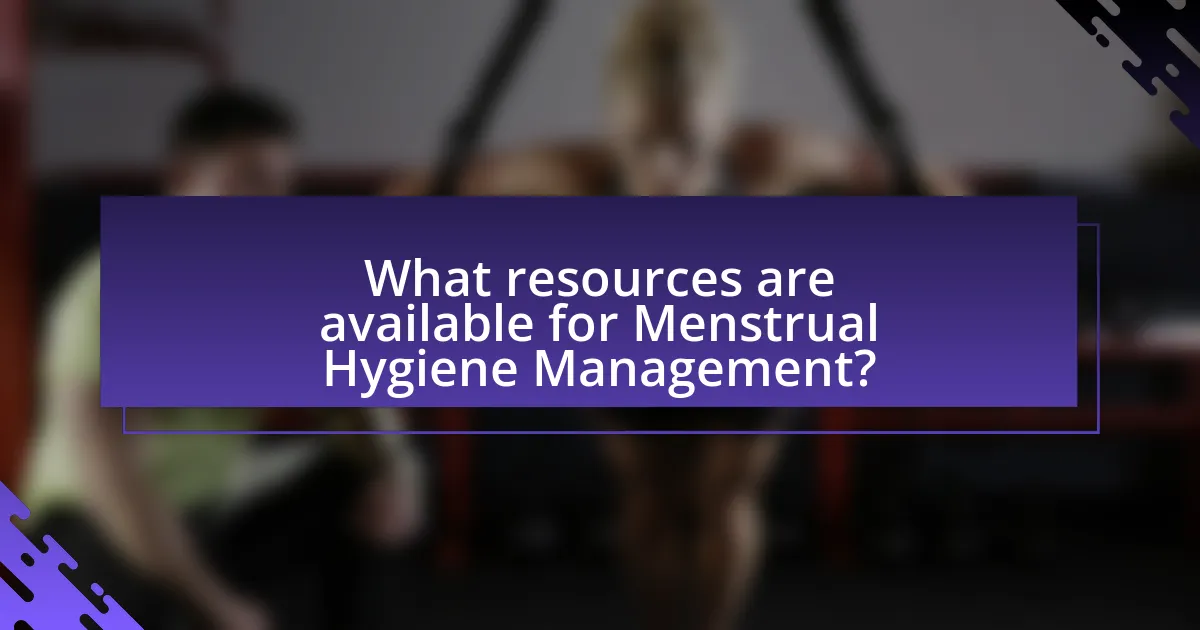
What resources are available for Menstrual Hygiene Management?
Resources available for Menstrual Hygiene Management include educational materials, menstrual products, and community support programs. Educational materials, such as brochures and workshops, help raise awareness about menstrual health and hygiene practices. Menstrual products include reusable cloth pads, menstrual cups, and disposable sanitary pads, which are essential for maintaining hygiene during menstruation. Community support programs often provide access to these products and facilitate discussions around menstrual health, ensuring that individuals have the necessary resources and knowledge to manage their menstruation effectively.
Where can communities find educational materials on menstrual hygiene?
Communities can find educational materials on menstrual hygiene through various reputable organizations and online platforms. For instance, the World Health Organization (WHO) provides comprehensive resources on menstrual health management, including guidelines and educational materials. Additionally, organizations like UNICEF and the Menstrual Hygiene Day initiative offer toolkits and resources specifically designed for community education. These materials often include pamphlets, videos, and workshops that are accessible online, ensuring that communities can easily obtain accurate and relevant information on menstrual hygiene practices.
What organizations specialize in menstrual health education?
Organizations that specialize in menstrual health education include the Menstrual Health Hub, which provides resources and information on menstrual health globally, and the Global Menstrual Health Coalition, which advocates for menstrual health rights and education. Additionally, organizations like Days for Girls focus on providing menstrual hygiene solutions and education to girls in underserved communities. These organizations contribute to improving awareness and access to menstrual health education, addressing the stigma and challenges associated with menstruation.
How can communities access funding for menstrual hygiene initiatives?
Communities can access funding for menstrual hygiene initiatives through various channels such as government grants, non-governmental organizations (NGOs), and crowdfunding platforms. Government agencies often allocate specific budgets for health and sanitation projects, which can include menstrual hygiene management. NGOs frequently provide grants or support for initiatives that align with their mission to improve women’s health and education. Additionally, crowdfunding platforms allow communities to raise funds directly from individuals who support menstrual hygiene initiatives, enabling grassroots mobilization. For instance, the Global Menstrual Health and Hygiene Coalition offers resources and guidance on securing funding for such projects, emphasizing the importance of community engagement and partnerships.
What practical tips can communities implement for better Menstrual Hygiene Management?
Communities can implement several practical tips for better Menstrual Hygiene Management (MHM), including providing access to affordable menstrual products, establishing safe disposal methods, and promoting education on menstrual health. Access to affordable menstrual products, such as pads and tampons, is crucial; studies show that when products are accessible, it significantly reduces absenteeism in schools among menstruating individuals. Safe disposal methods, like designated bins for menstrual waste, help maintain hygiene and prevent environmental pollution. Furthermore, educational programs that inform both menstruators and non-menstruators about menstrual health can reduce stigma and promote understanding, leading to a supportive environment. Research indicates that comprehensive education can improve knowledge and attitudes towards menstruation, fostering a culture of respect and care.
How can awareness campaigns be effectively organized?
Awareness campaigns can be effectively organized by clearly defining the target audience, setting specific objectives, and utilizing multiple communication channels. Identifying the demographic and cultural characteristics of the audience ensures that the message resonates and is relevant. Establishing measurable goals, such as increasing knowledge about menstrual hygiene management by a certain percentage, provides a clear direction for the campaign. Employing diverse platforms, including social media, community workshops, and local events, maximizes outreach and engagement. Research indicates that campaigns using a combination of methods can increase participation and retention of information, as seen in studies on health education initiatives.
What strategies can be used to engage men and boys in menstrual hygiene discussions?
To engage men and boys in menstrual hygiene discussions, educational programs that promote awareness and understanding of menstrual health are essential. These programs can include workshops, community discussions, and school curricula that address the biological, social, and cultural aspects of menstruation. Research indicates that involving men and boys in these conversations can reduce stigma and promote supportive behaviors, as evidenced by a study published in the journal “BMC Public Health,” which found that inclusive education significantly improved attitudes towards menstruation among male participants. Additionally, using relatable language and real-life scenarios can help demystify the topic, making it more accessible and relevant to young males.
